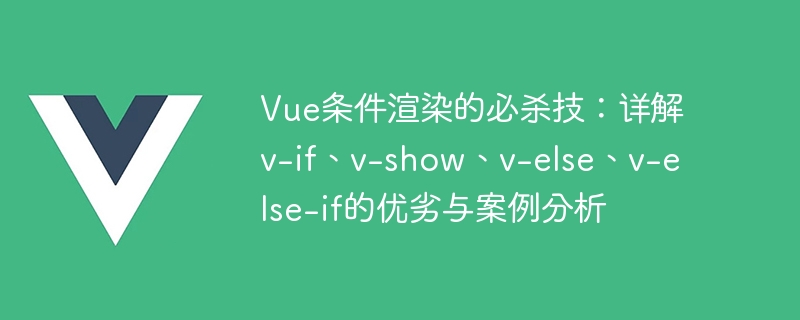

The nirvana of Vue conditional rendering: detailed explanation of the advantages and disadvantages of v-if, v-show, v-else, v-else-if and case analysis
Introduction:
In Vue development, conditional rendering is a very important feature. Vue provides several commonly used instructions to implement conditional rendering, including v-if, v-show, v-else and v-else-if. These instructions can dynamically insert or remove DOM elements based on whether an expression is true or false. This article will explain in detail the usage, advantages and disadvantages of these instructions, and further analyze them through actual cases.
1. v-if instruction
The v-if instruction is the most commonly used conditional rendering instruction in Vue. It determines whether to render a DOM element based on whether the expression is true or false. When the expression is true, v-if will insert the corresponding DOM element into the page; when the expression is false, v-if will remove the corresponding DOM element from the page. The following is an example of using the v-if directive:
显示文本
In this example, when show is true, the DOM element that displays the text will be rendered; when show is false, the DOM element will be moved remove.
Advantages and disadvantages of the v-if directive:
Advantages:
Disadvantages:
2. v-show instruction
The v-show instruction is similar to the v-if instruction. It can also switch the display state of the element based on the true or false expression. The difference is that the v-show instruction is implemented by modifying the display attribute of the element, rather than directly inserting and removing DOM elements. The following is an example of using the v-show directive:
显示文本
In this example, when show is true, display: block will be used to display the corresponding DOM element; when show is false, display will be used : none hides the corresponding DOM element.
Advantages and disadvantages of the v-show instruction:
Advantages:
Disadvantages:
3. v-else and v-else-if instructions
The v-else and v-else-if instructions are two supplementary instructions in conditional rendering. They can be used with the v-if or v-show directives to implement more complex conditional rendering logic. The following is an example of using the v-else and v-else-if instructions:
不及格
及格
优秀
In this example, different text will be rendered according to different values of score. When the score is less than 60, "Fail" will be rendered; when the score is greater than or equal to 60 and less than 80, "Pass" will be rendered; in other cases, "Excellent" will be rendered.
Advantages and disadvantages of v-else and v-else-if instructions:
Advantages:
Disadvantages:
Case analysis:
The following is a specific case showing the usage scenarios, advantages and disadvantages of v-if, v-show, v-else, and v-else-if instructions:
- {{ item }}
{{ item }}暂无数据更多信息
In this case, different data display methods can be displayed by clicking the button to switch the view type. When the view type is 'list', a ul list will be rendered; when the view type is 'grid', a set of div grids will be rendered; when the view type is empty, "No data yet" will be displayed. At the same time, by controlling the value of showMoreInfo, you can decide whether to render "more information".
Through this case, we can see the flexibility, advantages and disadvantages of using v-if, v-show, v-else-if, and v-else instructions. In actual development, we can choose appropriate instructions to perform conditional rendering operations according to specific situations.
Summary:
Vue’s conditional rendering instructions v-if, v-show, v-else, v-else-if are very commonly used in Vue development. Through detailed explanations and case studies of these instructions, we understand how to use them and their advantages and disadvantages. In actual development, we should choose appropriate instructions based on specific needs to achieve the best rendering effect and user experience.
The above is the detailed content of The nirvana of Vue conditional rendering: detailed explanation of the advantages and disadvantages of v-if, v-show, v-else, v-else-if and case analysis. For more information, please follow other related articles on the PHP Chinese website!




